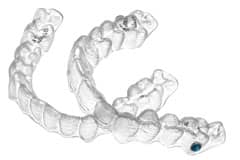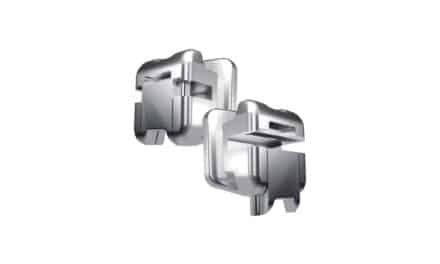by Ben Burris, DDS
An orthodontist’s first impressions of Invisalign Teen
 |
Ben Burris, DDS, is in private practice in Jonesboro, Hot Springs, West Memphis, Forest City, Benton, and Piggott, Ark. He is an Invisalign Premier Provider, and here he offers his first impressions of the new Invisalign Teen system.
OP: How did you get into using Invisalign?
Ben Burris, DDS: Where I went to school [University of Tennessee at Memphis], we didn’t even say that word. I went to a certification when I was in school and wasn’t really impressed, didn’t like it. I thought that I had to do it with braces to do it right. Once I started practicing, I just kept having people coming and asking for it, so instead of talking them out of it, I went to a certification, and the orthodontist who did it was really good and had some really nice results.
Then I treated myself, and I’ve been on board ever since. I wanted to try it on me before I tried it on anybody else, and I was really amazed. I had significant ortho relapse and some big rotations in my lower incisors, and had lost some arch width. It took me six aligners and I did a little refinement, a little upper correction, and I was done. My wife was after me for years to do braces, but I wasn’t going to do it. My old man was an orthodontist, and I had braces three times as a kid, I had a headgear, I had a Frankel appliance, which I would not wish on my worst enemy. I was the experimental child, so I was not going to have braces again.
 |
| Ben Burris, DDS |
OP: How long have you been using Invisalign Teen?
Burris: This March, Premier Providers could get it early, before everybody else could, and we’ve been doing it since then.
OP: How many teen cases have you treated?
Burris: I’d say 80 or 90.
OP: Is Invisalign Teen working as you expected?
Burris: It was pretty natural for us, being Invisalign folks. All things being equal, the kids would rather have the clear stuff. We’ve just found that this works really well for us. One big advantage of Invisalign Teen is that we can treat cases when the canines, premolars, and molars are not fully erupted.
One of the other big issues that we were worried about was kids keeping up with their aligners, but we’ve had no problem with that because we’ve got the orthodontic nuclear weapon: I tell them that if they lose their aligners too much I’ll just put braces on them. I can think of two aligners that were lost, and we’ve treated a bunch of cases. Even when they lose aligners, getting replacements from Invisalign with the free replacements is no big deal.
Then there are the wear indicators. The moms really enjoy that. I give them a little card and let them check that. I don’t even check them. I can tell whether patients wear them or not because the teeth either move or they don’t.
OP: How about hygiene issues?
Burris: We don’t have hygiene issues with Invisalign teen, and there are no emergencies. If you lose your aligner, it’s not something that I have to go up to the office at 8 o’clock at night on a Saturday to deal with.
OP: What are the differences between doing Invisalign in adults and in teens?
Burris: Really, none. The ClinCheck is a little different. You have a couple more variables there, but basically it’s the same. The only thing it does is give you more options, like having a couple more clubs in your golf bag. It gives you options to handle situations with teeth that are not fully erupted or second molars that are not in.
OP: How hands-on are you with ClinChecks?
Burris: I don’t claim to be a ClinCheck guru. I do the ClinChecks, and if I see something I don’t like, I’ll talk to Invisalign about it, but basically I’ve had good success. As a Premier provider you get a designated tech, and I’ve been satisfied with the way it goes. We do midcourse corrections every once in a while, do some refinements, but I just haven’t had a whole lot of issues with them.
I think a lot of it has to do with the diagnosis on the front end. There are certain things that you just can’t do with Invisalign: derotating severely rotated canines is not practical, closing bites is not practical. There are guys who can do it, who are better than me. They can do it. I’ll put braces on those cases. I’d say half the people who come to my office I can do Invisalign on, say half again are solid Invisalign candidates. We’re getting more and more of them to do Invisalign because we have no age issue; we don’t have emergency issues; the kids like it; and once you get comfortable with it, it’s pretty straightforward.
 |
OP: Do you think it has affected the flow in your practice? Are you able to see more or fewer patients?
Burris: The Invisalign appointments are very easy: come in, make sure they’re tracking, check the contacts. It’s a 3- to 5-minute appointment with very little open-mouth time. We’re trying to position ourselves as the Invisalign Teen people. I’ve got a truck that has “Invisalign” on it, and I’ve also got a 13-passenger van that has “Invisalign Teen” on it. That’s the van that I take my staff back and forth to different offices in.
OP: Speaking of which, did you have to do additional staff training for Teen?
Burris: No, it’s the same process. I had to show them the wear indicator, but again, that’s for moms more than for me. Either the teeth are moving and the aligners are tracking or not. If I monitor the wear indicators, I’m taking the patient’s problem and making it my problem. I like to give patients tools and let them be responsible for themselves. I’m sure at some point, the kids will figure out a way to circumvent the wear indicators and put it on the Internet. If they’d spend the time and effort doing what we asked them to rather than figuring out ways not to do it, then the world would be a great place.
OP: Has there been a difference in treatment time between Invisalign for adults and for teens?
Burris: I don’t see any difference in time.
OP: How about braces versus Invisalign on teens?
Burris: Invisalign, when worn properly, will get them to finish up quicker than braces from what I’ve seen. Just because of the nature of the appointments, the lack of breakage, that kind of thing. I tend to treatment-plan less time for Invisalign than I do for brackets. An 18-month case in braces I’ll schedule for 12 months in Invisalign. Again, I don’t claim to be a clinical guru.
OP: What else should orthodontists know about Teen?
Burris: The biggest thing is that this is a separate patient population. You’re not cannibalizing your fixed cases to get Invisalign cases. The people who want Invisalign, by and large, do not want to wear braces.
|
For complete information about products mentioned here, visit our online Buyer’s Guide. |
The consumer is changing. It used to be that you would tell them, “This is what you’re going to do.” But now the moms are saying, “No, I want to do this.” I was resistant for 2 years, and it’s a great product. I love it. Sometimes, it makes us feel as orthodontists that we’re not valuable enough or integral enough to the process if we can use Invisalign to get the desired results and we don’t have to make all kinds of funky bends to an archwire, but if we make our lives easier and we get good results and the patient is happy, why not do it?
Invisalign and Invisalign Teen are great practice builders inside and outside my practice. I tell my GP friends, “If you don’t like happy patients and more money, don’t do Invisalign.” I get many, many more referrals from GP offices that do some sort of orthodontics than from those that don’t because they are looking for orthodontic cases and they treat very few themselves.
Ben Burris, DDS, can be reached at










